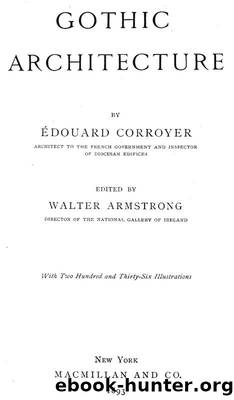Gothic Architecture by Édouard Corroyer

Author:Édouard Corroyer
Language: eng
Format: mobi, epub
Published: 2017-05-10T00:00:00+00:00
From the earliest centuries of the Christian era communities both male and female had been formed with the object of living together under a religious rule; but it seems evident that the greater number of monasteries owed their fame and wealth, if not their actual origin, to the reputation of their relics. These attracted the multitude. Pilgrimages became so frequent, and pilgrims so numerous, that it was found necessary to build hospices, or night-refuges, in various towns on their routes. A confraternity of the Pilgrims of St. Michael was formed in the beginning of the thirteenth century in Paris, where the confraternity of St. James of Pilgrims had already built its chapel and hospital in the Rue St. Denis, near the city gate.
From the seventh to the ninth century important abbeys flourished in nearly all the provinces now comprised in modern France. Later, under the immediate successors of Charlemagne, great monasteries were founded in all the countries which made up his dominions. Charlemagne himself had greatly contributed to the development of religious institutions by his reliance on the bishops, and more especially the monks who represented progress, supported his policy, and enforced his civilising mission. But after his death the study of art and science declined so rapidly that a radical reform became necessary in the tenth century, a reform which seems to have had its birth in the Benedictine Abbey of Cluny, established in Burgundy about the year 930.
From this hasty sketch of monastic organisation some idea may be gathered of the importance of religious institutions in the eleventh and twelfth centuries, and of the immense services they had rendered the State by diligent and useful toil, among the chief fruits of which must be reckoned the revival of agriculture, and the development of the sciences and arts, more especially architecture.
Monastic architecture exercised a great and decisive influence upon national art by its vast religious buildings, the precursors of our great cathedrals.
Download
This site does not store any files on its server. We only index and link to content provided by other sites. Please contact the content providers to delete copyright contents if any and email us, we'll remove relevant links or contents immediately.
Aircraft Design of WWII: A Sketchbook by Lockheed Aircraft Corporation(32215)
The Great Music City by Andrea Baker(31369)
Call Me by Your Name by André Aciman(20375)
The Secret History by Donna Tartt(18851)
The Art of Boudoir Photography: How to Create Stunning Photographs of Women by Christa Meola(18538)
Shoot Sexy by Ryan Armbrust(17659)
Plagued by Fire by Paul Hendrickson(17334)
Portrait Mastery in Black & White: Learn the Signature Style of a Legendary Photographer by Tim Kelly(16953)
Adobe Camera Raw For Digital Photographers Only by Rob Sheppard(16906)
Photographically Speaking: A Deeper Look at Creating Stronger Images (Eva Spring's Library) by David duChemin(16623)
Ready Player One by Cline Ernest(14527)
Pimp by Iceberg Slim(14397)
Bombshells: Glamour Girls of a Lifetime by Sullivan Steve(13977)
The Goal (Off-Campus #4) by Elle Kennedy(13543)
Art Nude Photography Explained: How to Photograph and Understand Great Art Nude Images by Simon Walden(12975)
Kathy Andrews Collection by Kathy Andrews(11731)
The Priory of the Orange Tree by Samantha Shannon(8892)
The remains of the day by Kazuo Ishiguro(8827)
Thirteen Reasons Why by Jay Asher(8799)
